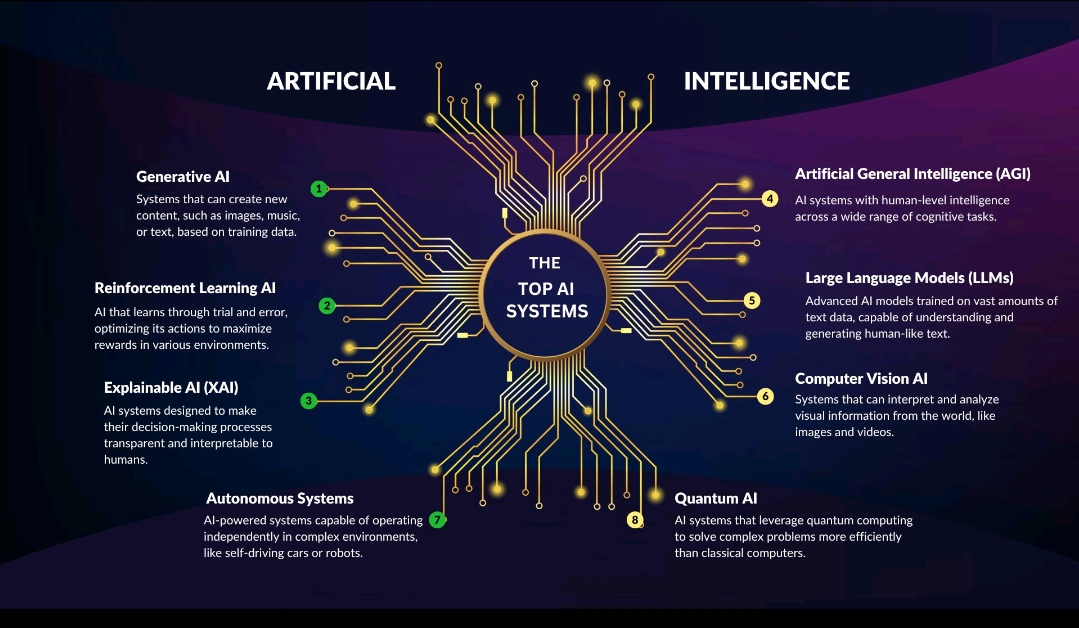
- Generative AI
Generative AI creates new content based on data, including drug discovery, diagnostics, and personalized treatments.
Example in Medicine: Generative AI is being used to create synthetic medical data, such as generating realistic patient scans for training purposes. This is especially useful in rare disease research, where patient data is scarce. The AI can create lifelike medical images that help in training radiologists without compromising patient privacy.
- Reinforcement Learning AI
Reinforcement Learning (RL) involves training AI systems through trial and error to achieve the best outcomes.
Example in Medicine: RL AI has been used in robotic surgery, where the AI learns to perform delicate surgical procedures through repeated practice. Systems like the da Vinci Surgical System use RL to improve the precision of actions such as suturing, reducing errors, and enhancing surgical outcomes.
- Explainable AI (XAI)
Explainable AI ensures that decisions made by AI systems are transparent and understandable by humans.
Example in Medicine: XAI models are now used in predicting patient outcomes, such as heart disease risk. Doctors can see which factors (e.g., age, lifestyle, medical history) most influenced the AI’s decision, enabling them to explain the diagnosis to patients and take preventative actions more confidently.
- Artificial General Intelligence (AGI)
AGI systems aim to replicate human-level intelligence across various tasks, offering long-term potential in healthcare.
Example in Medicine: While AGI is still in development, research is underway to create AI systems that can autonomously manage entire hospitals—from diagnosis to treatment planning. For example, future AGI could integrate various medical specialties and propose tailored, holistic treatment plans for complex diseases like cancer, considering every possible medical outcome.
- Large Language Models (LLMs)
LLMs are advanced AI systems trained on vast amounts of text data, capable of processing and generating human-like language.
Example in Medicine: LLMs like GPT-4 are being used to draft medical research papers, summarize patient histories, and even assist in diagnosing patients by parsing symptoms described in medical notes. This reduces the burden on physicians and allows them to spend more time with patients.
- Computer Vision AI
Computer Vision AI systems analyze visual data, such as images and videos, which is critical in medical diagnostics.
Example in Medicine: In dermatology, computer vision AI has been used to analyze skin lesions for early detection of melanoma. AI models trained on millions of skin images can now identify potentially cancerous moles with high accuracy, assisting dermatologists in making quicker, more reliable diagnoses.
- Autonomous Systems
Autonomous systems can operate independently in complex environments, enhancing their use in medical settings.
Example in Medicine: Autonomous drones are being used to deliver medical supplies to remote or disaster-stricken areas, transporting blood, vaccines, and medications in a timely manner. This reduces delivery times in critical situations, saving lives where traditional transportation methods are too slow.
- Quantum AI
Quantum AI uses quantum computing to tackle problems that are too complex for classical computers, which is especially valuable in data-heavy fields like genomics.
Example in Medicine: Quantum AI is expected to revolutionize drug discovery by simulating molecular interactions at an atomic level, speeding up the process of identifying new drug candidates for diseases like Alzheimer’s and cancer. By simulating every possible molecular interaction, quantum AI can find optimal drug combinations faster than any classical method.